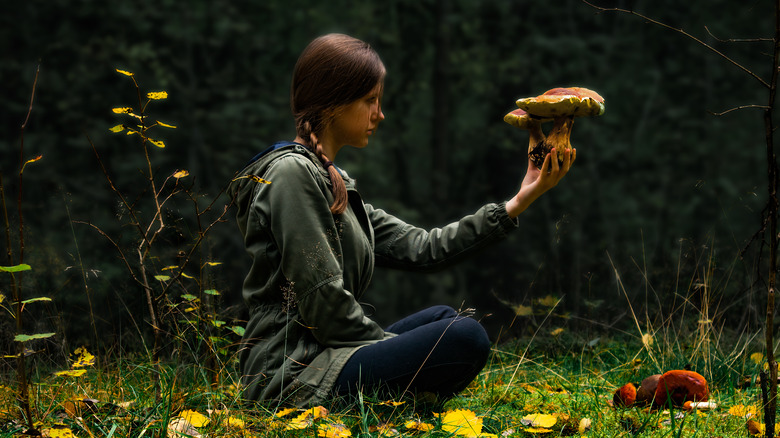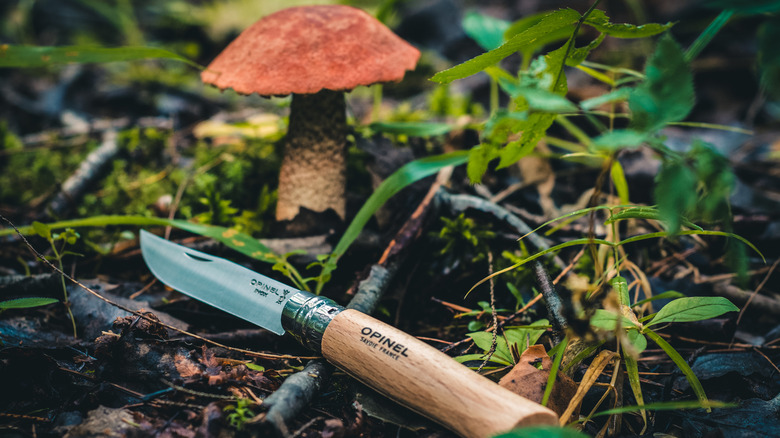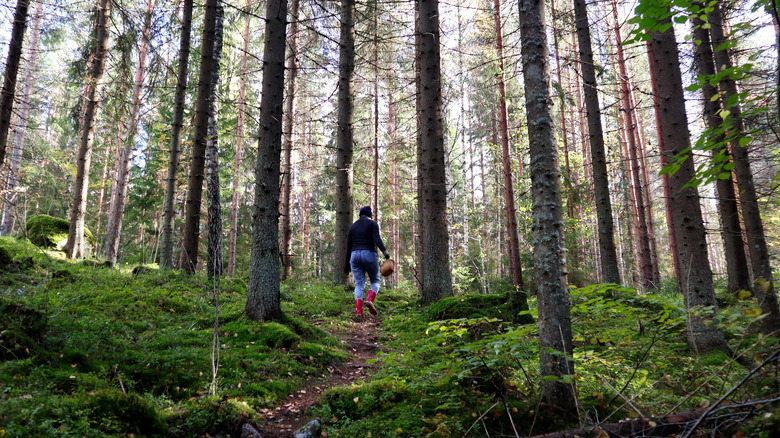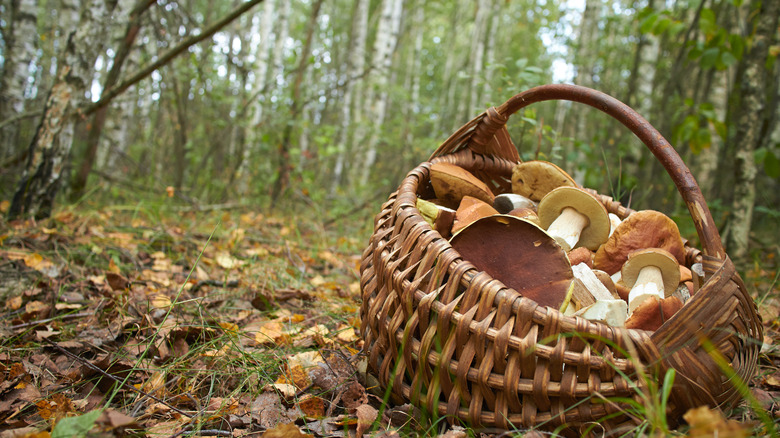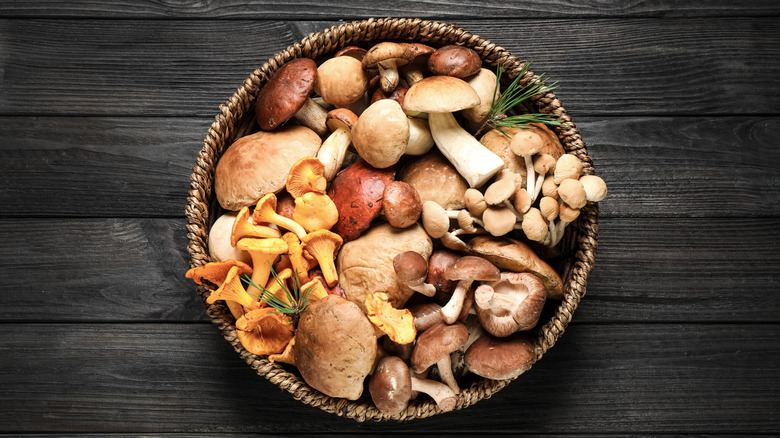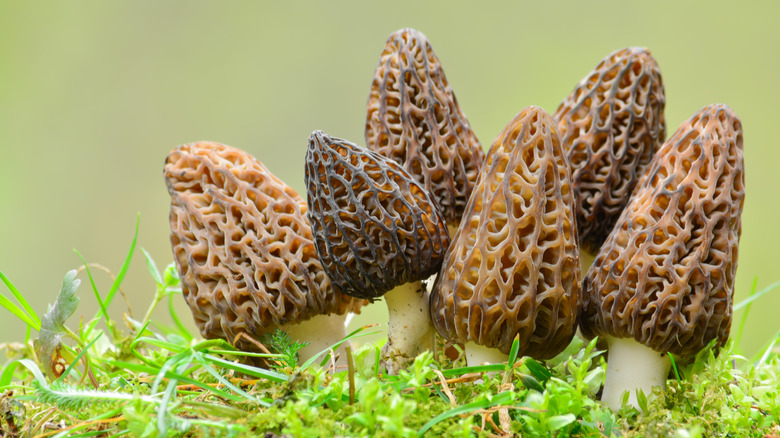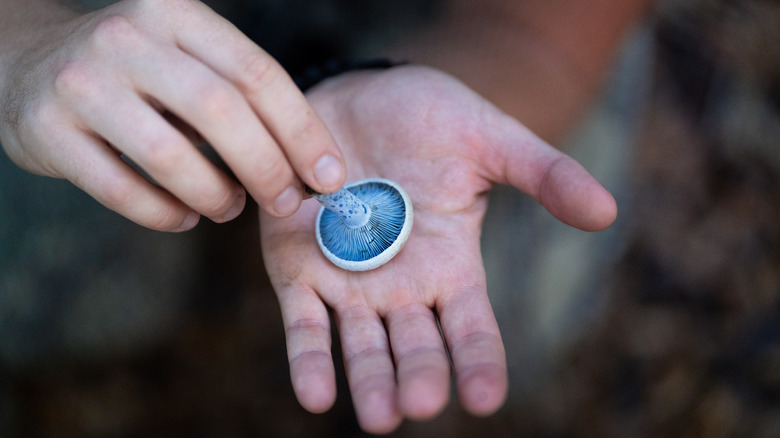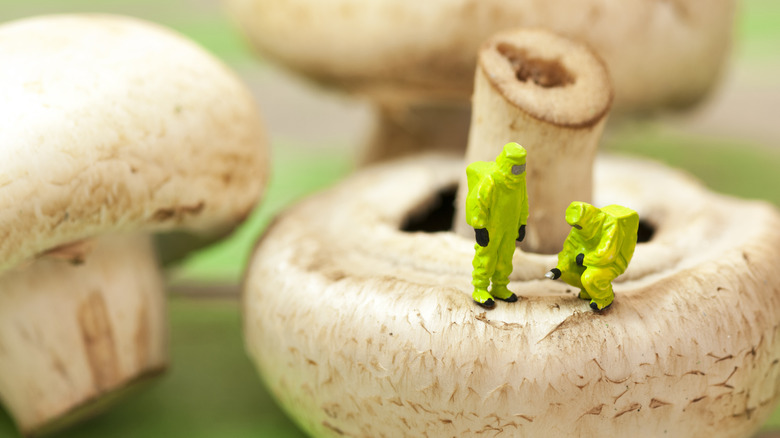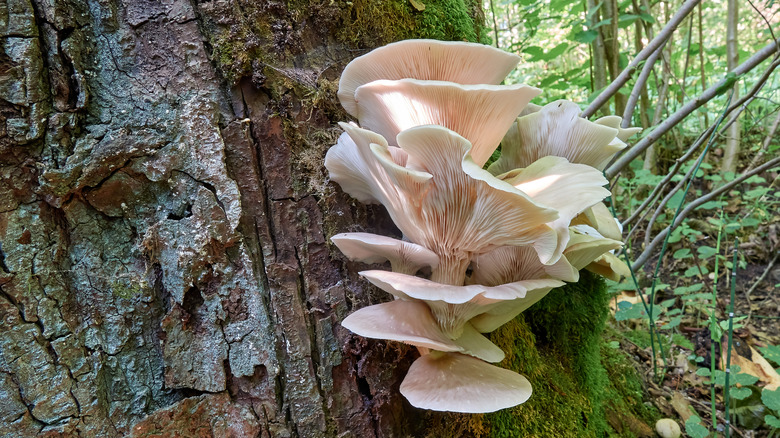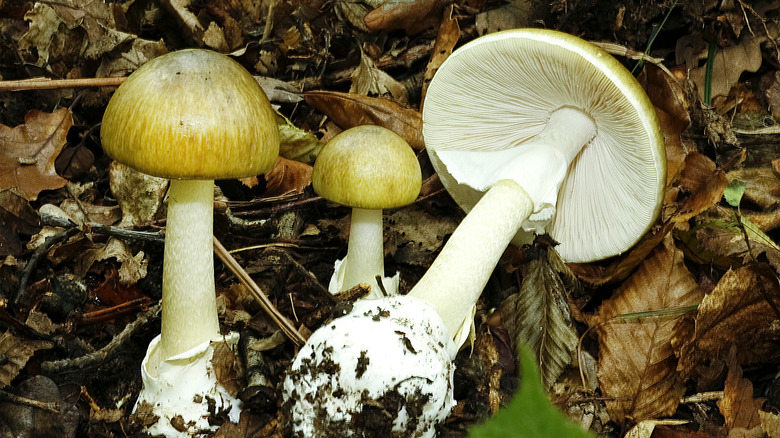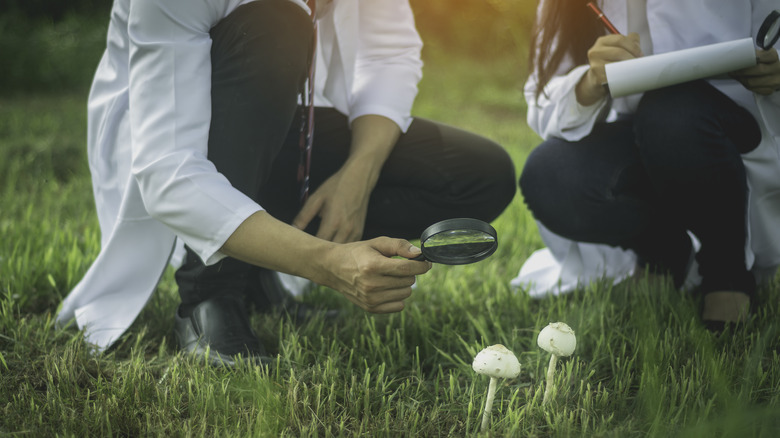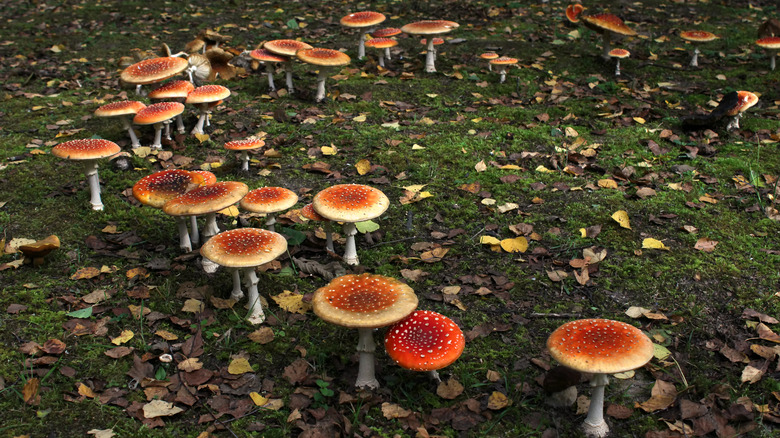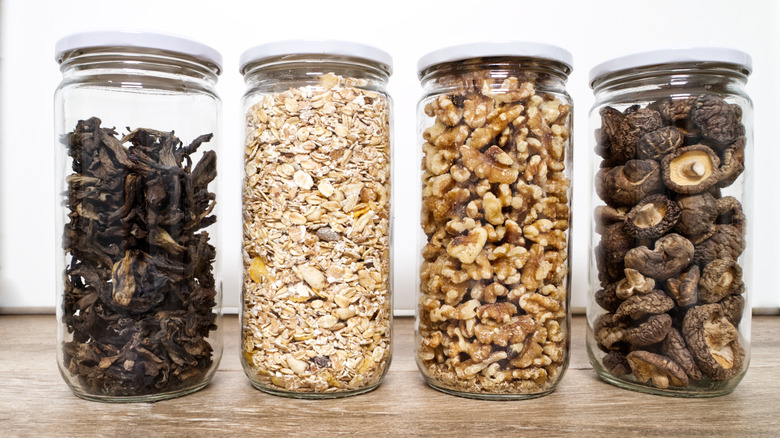How To Hunt For Mushrooms And Not Die
Mushrooming, mushroom foraging, and mushroom picking are just some of the common terms to describe mushroom hunting. They all refer to what comes as an age-old tradition passed down from one generation to the next: the search and gathering of wild mushrooms. Mushroom hunting spans the globe and can take place around forests, open fields, mountains, and even near the sea (via Afar).
You might enjoy eating creamy pasta dishes with crispy mushrooms, warm mushroom soups, and buttery mushroom jacket potatoes. But it's definitely not a good idea to go out and hunt your own mushrooms for these recipes without scoping the landscape first. Some mushrooms can be incredibly lethal. Hence, the most crucial part of hunting is to know everything you possibly can about the topic and even then to go with an established expert. If you've ever had your curiosity piqued by this elusive activity, read on to learn all you need to know before getting started.
Bring the right tools along
A large chunk of the fun when starting a new activity lies in collecting the equipment required before going out into the field. Mushroom hunting is no different. According to Backyard Forager, there are a few essential items that will not only make your explorations more gratifying, but generally simpler. Chief among these is a mushroom knife that comes with a curved blade to cut your fungus off the ground or tree barks. As well, you'll want to have a brush on hand for cleaning the soil off your mushrooms.
Next, you'll want to bring individual paper bags or waxed paper sheets to keep the various types of mushrooms separate. Collection baskets, bags, buckets, and mesh totes can also be used, preferably ones that allow your mushrooms to breathe. You absolutely have to have a guidebook –- or several — to help you identify your finds and to confirm and reconfirm your edibles.
Other supplies that will make your hunt that much more comfortable include a map, compass, or any type of navigation device that will help you find your way through (and back out) forests and fields. Bells, whistles, or other noisy tools can serve to deter wildlife or locate fellow hunters if you get lost. Basics such as water to stay hydrated, weather-appropriate shoes and clothing, insect repellent, sunscreen, and snacks are other articles to pack along (via Modern Forager).
Check local mushroom hunting regulations
Just because you are ready to go with all your equipment, curiosity, and expertise in tow, it doesn't mean that you can immediately make a dash into the foraging fields. You're going to want to first check whether it's lawful to hunt at your chosen spot. According to the USDA Forest Service, anyone who is 12 years old and above requires a permit to harvest mushrooms on public land.
The majority of mushroom hunters forage for personal use and can obtain free permits that must be renewed annually. These grant you permission to harvest a maximum of five gallons of mushrooms per day. Specifications as to how the mushrooms should be cut are also indicated. It goes without saying that any mushrooms picked with personal permits cannot be sold.
You can hunt on private property (with permission), in some state parks, national forests, community gardens, and occasionally even wildlife management areas (via Mycelium Society). The most important factor is to do your due diligence by asking for permission and finding out if you are allowed to pick mushrooms at your desired spot. Some national parks may also allow you to pick tiny amounts, but again, do not assume it's okay without finding out first.
Choose the best time of the year
With the extensive number of mushroom species out there, there is no single best time to go mushroom hunting. Various types are growing year-round so you will need to look into the specific species you are hunting to observe patterns across seasons. If you're really committed, you may even have to track their fruiting patterns across years and note specificities such as weather conditions, location, and time of day.
According to Mushroom Huntress, in various parts of the U.S. you're likely to start finding morels and oyster mushrooms during spring; chicken of the woods in late spring; chanterelles and lobster mushrooms in the summer and fall; lion's mane, porcini, black trumpets, giant puffballs, and hedgehogs in late summer; and hen of the woods in late fall. Nonetheless, you should still learn about regional fruiting seasons as well as the general pattern of mushroom finds over time.
Learn about popular and safe mushrooms
When you're only just beginning to edge into the world of mushroom hunting, you're better off hunting for popular and safer mushrooms. According to Field & Stream, these are usually easier to identify and don't bear intricate resemblances to toxic species. The outlet describes common fungi that are a good starting point for novice foragers.
Puffball mushrooms are one example; their spores grow internally and they are shaped like balls ranging from the size of a marble to a basketball. Chanterelles are recognizable by their orange, yellow, and pale gold colors as well as their funnel-like shape. Meanwhile, as the name suggests, oyster mushrooms are white and look like oysters, growing only on trees and logs. Another mushroom whose look is all in the name is a lion's mane. When fresh, it is white and looks more like a ball of hair tendrils plastered against a tree. Brightly colored and purported to actually taste like its namesake, chicken of the woods is also found on trees. Where there's one, you'll usually find plenty more.
Per MeatEater, other popular wild mushrooms for beginners include hen of the woods which is similar to chicken of the woods with regards to shape, size, and growing location, but brown in color. More commonly known as porcini, bolete mushrooms have large heads and bulging stems, boasting natural colors. Almost all its species — about 300 –- are edible.
Discover which mushrooms are especially revered
It's difficult to have your interest piqued by mushroom hunting without hearing whispers about infamous morel mushrooms. But exactly why are they such a big deal in the foraging world? For starters, eating morel mushrooms is a coveted culinary experience and a lap of luxury for your taste buds. A pound of fresh morels can range anywhere from $20 to $100, while dried morels regularly demand $160 to $450 on the market (via It's Foodtastic).
These hollow honeycomb-like mushrooms are rare and fruit only in the spring. They offer rich umami flavors and scents paired with an elegant texture, not to mention they boast an impressive nutrient profile. However, they are exceptionally difficult to grow which makes wild morels a popular delicacy in the U.S., Europe, and even back in ancient Rome (via USDA). According to Food Network, morels are incredibly versatile and can be used in soup, salad, pasta, and pizza. For a simple and tasty side dish, panfry the mushrooms on their own. They can be both prepared fresh or preserved and dried, producing differing but equally unique flavor profiles.
Use several sources to identify your mushrooms
When it comes to mushroom hunting, you can never be too safe, especially since edible wild fungi often have look-alikes that are toxic and even deadly. Your best bet is to initially go on hunting trips with an expert who can guide you along the way. There are plenty of other resources that can help you identify mushrooms when you eventually venture out on your own.
The North American Mycological Association is a great source for finding books about wild mushrooms in North America, North American regions, and specific groups of mushrooms. There is also a catalog of miscellaneous mushroom hunting books that you can scour depending on your particular needs and interests.
In addition to books, there are several mushroom identification apps you can use to confirm your bounty. Among these are Picture Mushroom, Mushroom Identificator, Shroomify, Book of Mushrooms, and Fungitron Mushroom Guide. And if you're more relational, there are plenty of mushroom hunting groups and clubs you can join. Mushroom the Journal offers an extensive reference list across North America in order to find nearby clubs. Regardless of the type of resource you prefer, it is always worth it to double-check your mushroom finds.
Only consume mushrooms that have been positively identified
The day has finally arrived: You've got your guidebook, your nifty hunting equipment is packed, your personal use permit is valid, and an entire park is in front of you to explore. Suddenly, little buds call to you from a distance in the ground or on tree bark. You approach, check them out, and while you're almost sure you recognize them as being edible, there's one tiny detail you are not completely certain about.
It is at this precise moment that you should remember one paramount rule. This counts even if you decide to harvest the mushroom anyway and store it separately from your other finds for further investigation later. Never consume a mushroom unless it's positively identified. When observing whether a mushroom is edible, you'll be checking details like body shape, stem, cap, undersides of the cap, the area where it is growing, and whether or not it is the appropriate season (via Sciencing). As a general rule, avoid mushrooms with red stalks or caps, white gills, and skirts or rings on the stalk.
Avoid simplistic guidelines about mushroom hunting
While myths and folklore are fun to share around campfires, buying into those about mushrooms can be dangerous. Mushroom hunting is a complex activity that requires specialized knowledge, so if anyone ever claims to have a simple formula, it's probably wildly inaccurate (via Bionity).
Ultimate Medicinal Mushrooms highlights a number of common generic guidelines and myths to avoid. For example, it is false that all white mushrooms are safe to eat, and the same goes for those with a peelable cap. While you might think that poisonous fungi are toxic to animals too, in fact, some species are only dangerous to humans. Nor is there any truth to the notions that poisonous mushrooms taste bitter, have pointy caps, or can't be found growing on wood. The idea that all mushrooms are safe to eat once cooked is also misleading.
These rules are far too simple to be considered as sound advice. Many people take years to perfect the art of mushroom foraging and even then, still invest in continued learning to ensure their own safety and that of the people they guide.
Know the most dangerous mushrooms to avoid
While it's important to know which mushrooms are the easiest and safest to hunt, it's perhaps more worthwhile to learn about the most dangerous mushrooms that need to be avoided. According to the BC Medical Journal, death cap mushrooms are responsible for 90% of all deaths related to fungi, aptly making them the most dangerous mushrooms in the world. It typically grows in Europe though it is starting to appear in North America. Britannica describes it as being a poisonous look-alike of the edible straw and caesar's mushrooms.
Meanwhile, destroying angels are white and look like standard button mushrooms. A poisonous look-alike of coveted morels, false morels encompass a number of different species but are not hollow like true morels (via The Great Morel). Autumn skullcaps are another dangerous species to watch out for. Mushroom Exam describes its caps as brown or yellowish-brown, and it contains similar toxins as those in death cap mushrooms (via Britannica). There are two species of webcaps –- deadly and fool's -– and the poison's effects are similar to symptoms of the common flu, making the toxicity hard to diagnose.
Commonly known as the second deadliest fungus in the world, poison fire corals are mostly found in Asia and can be identified by their red solid bodies (via Mushroom Exam). The deadly dapperling is a white brown blotchy mushroom that grows in areas with ample grass, erroneously identified as an edible species.
Stay away from look-alikes until you're an expert
As people gain more and more experience mushroom hunting, they may naturally become drawn to exploring the world of look-alikes. However, this is a part of mushrooming that you should probably leave to the experts — at least until you are an expert yourself over years of learning. It just so happens that several of the deadliest mushrooms look like some of the most prized and fiercely hunted edible mushrooms.
A prime example is morel mushrooms and false morels. Death caps resemble edible Asian paddy straw and caesar's mushrooms while destroying angels look like your everyday common button mushrooms (via Britannica). Interestingly, although puffball mushrooms are considered to be one of the easiest species to identify, death caps look like them before they have fully grown — a truly deadly mistake to make while you're still learning (via Mushroom Exam). Even if you are insatiably curious about look-alikes, you're better off staying away altogether. Unless of course, your expert foraging mentor is going on the hunt and allows you to tag along.
Be prepared in case you consume a poisonous mushroom
You could know everything there is to know about mushroom hunting and still (though hopefully never) make the mistake of consuming a poisonous mushroom. As such, it's important to know how to navigate this potential outcome. Per the North American Mycological Association, there are 14 different types of mushroom poisoning syndromes found around the globe. Out of these, 10 have been documented in North America, albeit poorly given the low frequency of consuming uncommon mushroom types. The most typical outcome is gastrointestinal distress.
Unfortunately, if you ever experience symptoms of poisoning from a toxic mushroom, you'll find that there is no set cure for your recovery. Instead, there are practical steps you can take after the fact. Ranker recommends first inducing vomiting to eliminate the toxin from your body. Collect a sample in a plastic bag in order to help your doctor determine what toxin you ingested. You can also carefully obtain a piece of the mushroom, storing it in a plastic bag to protect it (and you).
Most importantly, make sure to get to the hospital as quickly as possible. You don't need to be displaying severe symptoms before you head to the doctor — just the inkling that you may have eaten a poisonous mushroom is enough. This is especially valuable because some symptoms present themselves only hours or days after the poisonous mushroom has been consumed (via Ranker).
Learn sustainable mushroom hunting practices
One general advantage of foraging is that if you do it locally, you're contributing to eco-friendly consumption. Since local produce does not need to be displaced across lands and seas, it is beneficial to the environment. Transporting food is a massive contributor to carbon emissions in the atmosphere, so cutting out the middle man is always a good start.
Nevertheless, it remains imperative to ensure that even as a mushroom hunter, you're being kind to the environment in exchange for the opportunity it provides as a host of adventures for your explorations and finds. Per Trails for Two, you can ensure that your mushroom foraging is sustainable by focusing on a few practices. For starters, only harvest about half of what you find so that more mushrooms can be propagated at any given site. Additionally, you should aim to pick only mature mushrooms as they've already released spores. By using porous collection bags like mesh totes, you'll keep dropping spores on the move, helping to renew the resource. Mushrooms are often symbiotic with surrounding vegetation which is why harvesting only a small amount is ideal to preserve the ecosystem.
